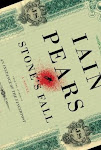
Someone in Amsterdam is enjoying my copy of Ambrosia.
I have torn my luggage apart, but somehow my copy did not make the flight home with me. It's sort of fitting, really, because according to Ambrosia, Amsterdam has a thriving electronic music scene. Sadly, I don't get to take advantage of that when I'm traveling there on business, but one of my earlier trips there coincided with the annual White Party. The White Party is a huge electronic music event, as well as being part of the annual Gay Pride week. I remember seeing the city awash in beautiful young people dressed all in white and feeling very out of place on the streets. All this to say that I'm writing this review from memory and my notes, without the book at hand, but I don't think I'll have any problem giving you a feel for it.
Ambrosia is an interesting sort of book. We've all read some study of a particular kind of music or a branch of the art world, and in that sense it does an excellent job of explaining the various genres and sub-genres (house, garage, trance, techno, break-beats, drum n' bass and hardcore), the people and places where this music came to life. What's unusual about this is the immediacy of it all. There is no filtering through time and history - the artists and DJs are people you here on the radio, titles that you've probably got on your iPod right now. The nightclubs and rave scenes are places you could go to this weekend (well, assuming you can afford a last minute flight to New York or Ibiza). This makes the book current in a way that is really appealing to me.
Now, that also means that there is no great historical distance on these artists and their music. While there is no denying this is a well-established genre and one that will likely continue to influence popular music for a long time, it is still too new, I think, to draw a lot of big, important conclusions. Author James Cummins tries - too hard, at times - to make big and broad statements about the impact of electronica music. This is still a young genre and only time will tell its long-term impact on the culture that surrounds it.
Cummins also paints a rather idyllic picture of the nightclubs and raves where electronica is most popular. As in all musical arenas, there are bad guys and good guys, but reading Ambrosia might give you the impression that the fans of electronica are all staunch anti-drug advocates; this has certainly not been my experience of raves and nightclubs. But if Cummins has an overly-rosy view of the scene, it's easy to overlook it. He quite obviously loves the music and is really passionate and enthusiastic about these artists and their work, and that scores real points with me.
I will say that my copy could have used a final edit for grammar and sentence structure (mixed tenses are painful to read), but mine may have been an ARC. I could check the book, if I had it, to be sure. Drat. Still, if you are a fan of any sort of electronic music, it makes a very enjoyable read. Check it out at Clark-Nova Books, where you can order direct from the publisher.
I have torn my luggage apart, but somehow my copy did not make the flight home with me. It's sort of fitting, really, because according to Ambrosia, Amsterdam has a thriving electronic music scene. Sadly, I don't get to take advantage of that when I'm traveling there on business, but one of my earlier trips there coincided with the annual White Party. The White Party is a huge electronic music event, as well as being part of the annual Gay Pride week. I remember seeing the city awash in beautiful young people dressed all in white and feeling very out of place on the streets. All this to say that I'm writing this review from memory and my notes, without the book at hand, but I don't think I'll have any problem giving you a feel for it.
Ambrosia is an interesting sort of book. We've all read some study of a particular kind of music or a branch of the art world, and in that sense it does an excellent job of explaining the various genres and sub-genres (house, garage, trance, techno, break-beats, drum n' bass and hardcore), the people and places where this music came to life. What's unusual about this is the immediacy of it all. There is no filtering through time and history - the artists and DJs are people you here on the radio, titles that you've probably got on your iPod right now. The nightclubs and rave scenes are places you could go to this weekend (well, assuming you can afford a last minute flight to New York or Ibiza). This makes the book current in a way that is really appealing to me.
Now, that also means that there is no great historical distance on these artists and their music. While there is no denying this is a well-established genre and one that will likely continue to influence popular music for a long time, it is still too new, I think, to draw a lot of big, important conclusions. Author James Cummins tries - too hard, at times - to make big and broad statements about the impact of electronica music. This is still a young genre and only time will tell its long-term impact on the culture that surrounds it.
Cummins also paints a rather idyllic picture of the nightclubs and raves where electronica is most popular. As in all musical arenas, there are bad guys and good guys, but reading Ambrosia might give you the impression that the fans of electronica are all staunch anti-drug advocates; this has certainly not been my experience of raves and nightclubs. But if Cummins has an overly-rosy view of the scene, it's easy to overlook it. He quite obviously loves the music and is really passionate and enthusiastic about these artists and their work, and that scores real points with me.
I will say that my copy could have used a final edit for grammar and sentence structure (mixed tenses are painful to read), but mine may have been an ARC. I could check the book, if I had it, to be sure. Drat. Still, if you are a fan of any sort of electronic music, it makes a very enjoyable read. Check it out at Clark-Nova Books, where you can order direct from the publisher.






2 comments:
Poor editing really bugs me - I find it hard to get past.
Poor editing? Try poor writing. This book is truly horrible. Self-involved, trite, shallow, sentimental, muddy, confusing, contradictory and conservative are just a few words that describe this piece of shit. Go elsewhere if you are looking for an in-depth and engaging analysis of electronic dance music.
Post a Comment